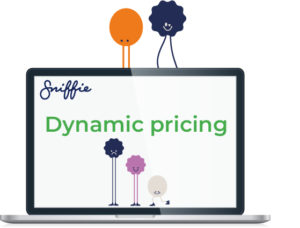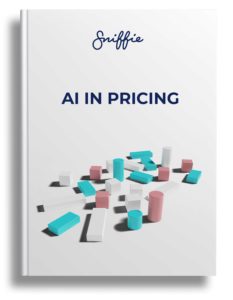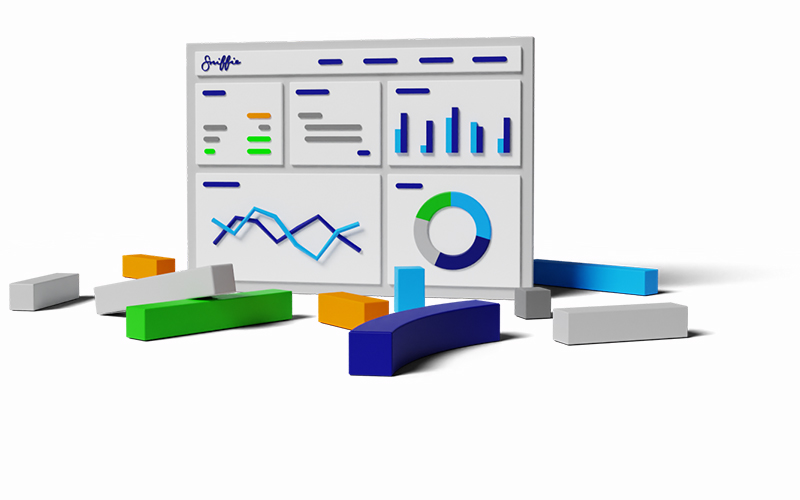What really is dynamic pricing definition? Although dynamic pricing with its various benefits is a powerful tactic in your eCommerce pricing strategy, it remains one of those buzzwords that gets thrown around so much that it barely means anything anymore.
That’s why we decided to dive into the topic and explain in simple terms everything you need to know about dynamic pricing. With these practical examples, our dynamic pricing guide guarantees you will quickly become a master of this pricing model.
Dynamic Pricing Definition
1. What is dynamic pricing?
Dynamic pricing is a pricing strategy that focuses on adjusting and determining the price of a product based on set variables. For example, competitor prices, customer demand, market trends, and availability of similar products. Dynamic pricing is exceptionally crucial in industries where demand fluctuates throughout the day or week, and impacts the availability as well as price of products. When market prices change, so does the price.
In essence, dynamic pricing provides the best price for customers at a particular time as it is always related to some product or market-based factors. This way, the approach is always connected to customers’ perceived value.
So why should your business rely on dynamic pricing? Short answer: to maximize profit.
2. Why is dynamic pricing important?
The rise of online shopping and new technologies (e.g. electronic self-labels) allow businesses to take advantage of more predictable and consistent pricing strategies. Dynamic pricing helps your business to thrive in the competition between you and your competitors as it allows you to dynamically react to market changes and offer the best possible value for your customers. In addition, it enables faster and more profitable sales, provides more control over product pricing and makes it possible to change prices in real-time and immediately observe results.
In addition, this dynamic approach to pricing generates better insights into market trends and customer behaviour by identifying the most selling items, the most significant competitors and their prices, and the best profitable price. It also allows you to calculate which competitor prices really affect your demand. This approach is called cross elasticity of demand.
When demand exceeds availability, there is room to increase the price as there are fewer products available than demand is. Conversely, when availability is higher than demand, it is wise to decrease the price to meet the demand.
Watch our webinar on dynamic pricing

3. Pros and cons of dynamic pricing
As with everything else in business life, dynamic pricing also comes with its perks and drawbacks. So let’s focus on the benefits first.
Optimised inventory turnover
By tracking your competitors’ campaigns and inventory, you can adjust your prices to reflect current demand and optimise your own inventory turnover. In addition, when your products have a high inventory, a gradual price reduction helps prevent overstocking and stimulates more sales.
Triggered purchase during low seasons
With the help of a dynamic pricing strategy, businesses can incentivise customers to shop during off-seasons by offering lower prices. However, some industries have a heavy seasonality element; thus, little encouragement to make purchases during the off-season is an efficient way to balance high and low demand.
Deeper insights into market trends and customer behaviour
You can observe market price levels and understand customer behaviour by monitoring your sales conversions. This helps to understand the relationship between purchases and prices. Practically, this tells what your customers are willing to pay for your products at different price points.
Increased gross margins by finding the best price point
With an improved understanding of customer behaviour patterns, you can analyse the lowest and highest price customers are willing to pay. Between those price points, the optimum price point generates the most value for you (sold units time gross margin) and your customers (the best price point for them at that moment). Dynamic pricing automatically helps you find the right price point.
More control over your pricing strategy
As dynamic pricing involves real-time tracking of price patterns (market price, demand or other variables), it allows you to adjust your product pricing whenever you need. In other words, it helps to understand supply-demand relations.
However, there are potential challenges related to the dynamic pricing approach:
- A hasty and unplanned implementation might cause an irrational price image of your company.
- If price changes happen frequently and your automation is set without consideration, this can potentially risk starting a price war.
- Dynamic pricing is less accurate if unpredictable demand fluctuations occur (for example, due to a crisis or force majeure situation), and your approach needs to be equipped to handle that.
Additionally, implementing an advanced dynamic pricing tool is a high-tech-dominated process. Frequent price changes require a great deal of competitor monitoring and market study, which, if done manually, requires plenty of resources. You shouldn’t get alarmed: these challenges can be tackled with a practical price monitoring tool.
Why machine learning and AI are the future of product pricing?
AI is a buzzword like no other. We sat down, wrote all we know about it and let you be the judge. Here is a seriously indepth 50-page insights on how to use artificial intelligence in pricing. Hope you find it useful!

4. Should your business use dynamic pricing?
Simple answer: YES, if you work in a field where market changes happen.
As prices are heavily affected by fluctuations in availability, market situation, and demand, profitable businesses should be equipped with the right resources to adjust their prices easily. The more fluctuating the demand is, the more applicable the dynamic pricing model becomes.
Once a dynamic pricing model is correctly set up, it brings additional revenue to your business and saves resources and costs effortlessly. You can offer competitive prices to your customers and be positioned on top of the market. When demand exceeds availability, there is room to increase the price. Conversely, it would be wise to decrease the price when availability is higher than demand.
On top of that dynamic pricing also decreases your digital marketing return on investment by making the best offer for every customer coming to your site.
5. Examples of dynamic pricing strategies
Here are four main approaches for your dynamic pricing strategy, especially in product-based eCommerce. Keep in mind that these pricing strategies can be combined. For example, if you want to maintain a certain profit level, you could combine competitor-based, value-based, and cost-plus pricing.
- Competitor-based pricing: the adjustment of prices is based on your competitors. You can easily use market pricing to base your price decisions by monitoring matching products.
- Cost-plus pricing: your prices are based on a desired margin and product cost. When your costs change, you can dynamically change product pricing to either raise sales volumes by lowering the price or optimise margins by raising the price.
- Value-based pricing, aka elasticity-based pricing: you focus on the willingness of customers to pay for the products; low-price elasticity products are suitable candidates for price changes since they are less sensitive to price changes. The convenient approach in products with no comparable products on the market.
- Time-based pricing: you adjust prices seasonally or at a specific time when demand changes or your product is about to expire.
6. How to start with dynamic pricing?
Before you implement dynamic pricing as your pricing model, you should consider certain aspects. With our helpful guidance, this will be easy for you.
How will dynamic pricing benefit your customers?
As eCommerce has significantly increased in recent years, customers diligently compare online prices and select businesses that offer the best deals. By gathering and analysing data on customer behaviour, you can accurately understand how customers react to pricing and adjust your prices accordingly to be appealing in the eyes of your customers. When your pricing creates value for the customers, they will buy from you.
Understand how dynamic pricing helps to achieve your business goals
Let’s look at an example. Your product price is 100 and your profit margin is 50. What do you do when your competitor sells the same product and drops the price to 60? If your overall operating margin doesn’t allow it, your model should not react to the price. Instead, let the competitor sell out and then get better margins from your products. To make dynamic pricing profitable, you need to know and understand how to react to such events.
Create a pricing strategy
From the very beginning, it is crucial to implement an efficient pricing strategy to secure its benefits and avoid unnecessary backlash. Pricing is not a set-and-forget business decision: just like your product portfolio, business strategy and competitive landscape change over time, and your pricing strategy should evolve.
Setting up dynamic pricing for eCommerce
Firstly, select products that benefit from dynamic pricing and create clear pricing rules for your highest and lowest price points to ensure your prices are never too high (your volumes dramatically drop) or too low (your margins take a hit). Secondly, avoid automation working against you by setting distinct pricing boundaries for upcoming price changes. To prevent the loss:
- Ensure your Key Value Items are either manually accepted or have tight automation policies.
- Analyse and use the information on your competitor’s campaigns and market changes.
- Come up with alternative actions for moments when you need to react.
- Ensure you rely on one pricing master where all price changes go to your eCommerce platform.
Create a monitoring and analysing process
Successful implementation of dynamic pricing needs a monitoring and analysing process to ensure your set model is profitable. Therefore, you can continuously monitor the factors affecting the market and how your profits develop against that. This is where monitoring tools and pricing dashboards become valuable. With accurate data, you can understand how to adjust your prices to be competitive based on a real-time, automated, and in-depth analysis of market demands.
FAQ
- How does dynamic pricing adapt to unpredictable demand fluctuations, such as those caused by crises or force majeure situations, and what challenges does this pose for businesses?
- Dynamic pricing adapts to unpredictable demand fluctuations by continuously analyzing market conditions, customer behavior, and other variables in real-time. However, challenges arise when demand fluctuates unexpectedly, such as during crises situations, as these events can disrupt traditional pricing models and require rapid adjustments to maintain profitability.
- Dynamic pricing adapts to unpredictable demand fluctuations by continuously analyzing market conditions, customer behavior, and other variables in real-time. However, challenges arise when demand fluctuates unexpectedly, such as during crises situations, as these events can disrupt traditional pricing models and require rapid adjustments to maintain profitability.
What specific resources and technological capabilities are necessary for implementing an effective dynamic pricing strategy, particularly in terms of competitor monitoring and market study?
- Implementing an effective dynamic pricing strategy requires specific resources and technological capabilities, including advanced pricing software or tools equipped with AI and machine learning capabilities. These tools enable businesses to monitor competitor prices, track market trends, and analyze customer behavior in real-time. Additionally, robust data analytics capabilities are necessary to conduct thorough market studies and identify pricing opportunities and challenges.
- Implementing an effective dynamic pricing strategy requires specific resources and technological capabilities, including advanced pricing software or tools equipped with AI and machine learning capabilities. These tools enable businesses to monitor competitor prices, track market trends, and analyze customer behavior in real-time. Additionally, robust data analytics capabilities are necessary to conduct thorough market studies and identify pricing opportunities and challenges.
Can you provide examples of businesses that have successfully implemented dynamic pricing strategies in industries with highly fluctuating demand, and what were the key factors contributing to their success?
- Successful implementation of dynamic pricing strategies in industries with highly fluctuating demand often involves a combination of technological sophistication, data-driven decision-making, and strategic agility. Examples of businesses that have achieved success with dynamic pricing include airlines, online retailers, and hospitality businesses. Key factors contributing to their success include the ability to quickly adapt to market changes, effectively analyze pricing data, and leverage advanced pricing tools to optimize pricing strategies in real-time.
Learn more about e-commerce pricing
All things e-commerce pricing & price optimization right in your inbox. No spam.


